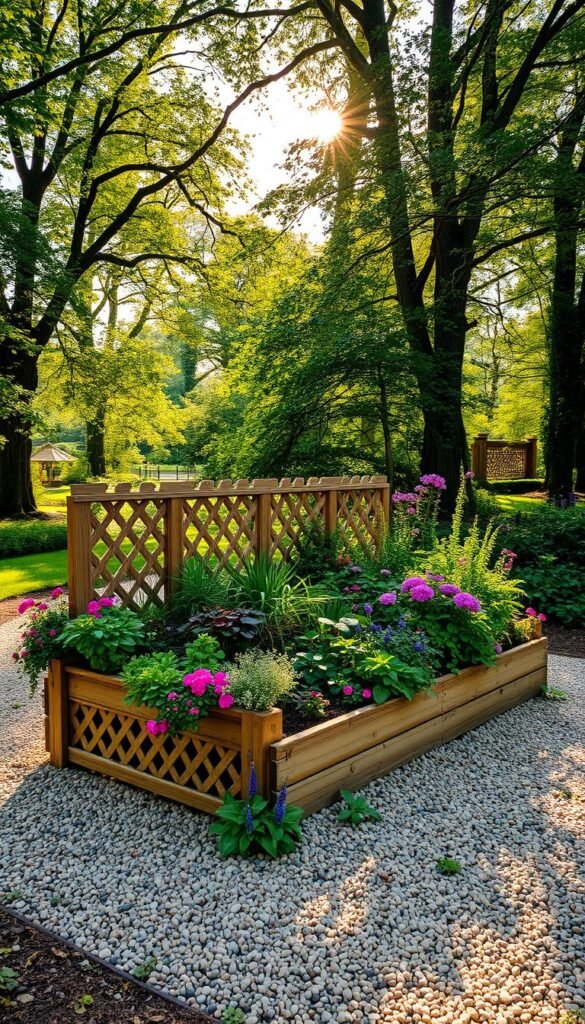Ever wondered how to turn your outdoor area into a space that’s both eye-catching and productive? Elevated planters offer a fresh way to organize your greenery while boosting your home’s charm. Whether you’re growing veggies, herbs, or flowers, these structures give you control over soil quality and drainage—key factors for thriving plants.
This guide dives into smart strategies for crafting outdoor spaces that work as hard as they shine. You’ll find out how thoughtful layouts reduce back strain and simplify care routines. From sleek modern arrangements to rustic cottage styles, there’s an approach to match every taste.
Why settle for ordinary when you can blend beauty with purpose? Properly planned beds create visual interest while maximizing yields. Materials like cedar, galvanized steel, or stone add texture and durability, letting your personality shine through every detail.
We’ll walk through ergonomic layouts, smart material choices, and plant pairings that thrive together. You’ll learn to balance color, height, and texture for arrangements that delight the senses season after season. Get ready to build a space that feeds both your body and your creativity.
Introduction: The Beauty and Benefits of Raised Garden Beds
Discover how elevated planters can revolutionize your outdoor space. These structures solve common growing challenges while adding visual appeal. By lifting soil above ground level, you create perfect conditions for roots to thrive.
Superior drainage prevents waterlogged roots, giving plants exactly what they need. You control soil quality completely—no more fighting clay or rocky earth. Choose materials like cedar for natural warmth or galvanized steel for modern durability.
Early spring planting becomes easier as contained soil warms faster. Built-in borders deter pests naturally while creating clean lines. Organized layouts boost curb appeal and may even increase home value!
- Customize heights to eliminate bending
- Group plants by water needs for efficiency
- Mix flowers and veggies for colorful displays
These growing spaces transform tricky yards into productive areas. They simplify maintenance while letting your creativity blossom season after season.
Ergonomic Raised Beds: Optimal Height for Comfort
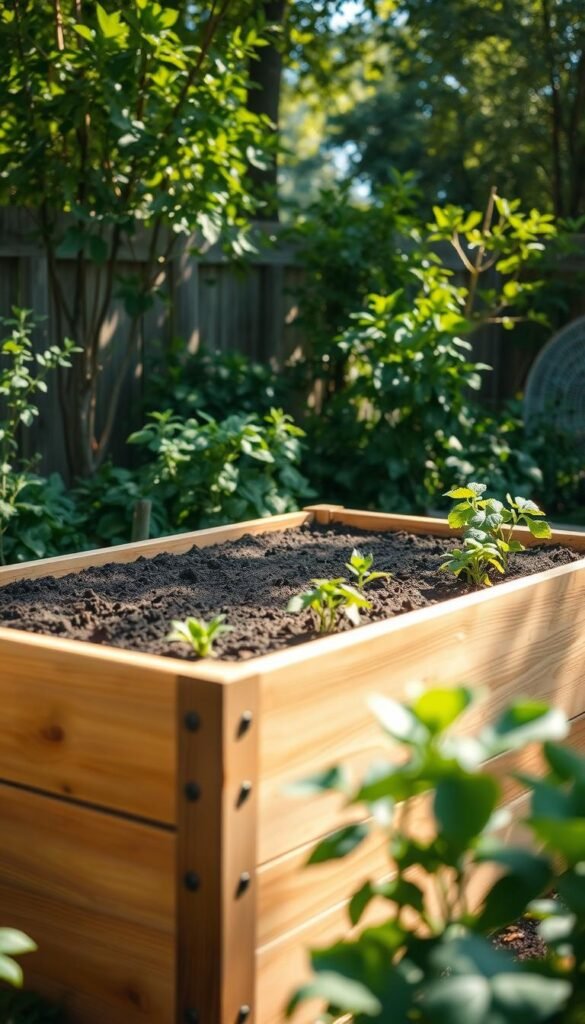
Imagine tending to your plants without the familiar ache in your knees or lower back. Elevating your growing zones to waist level changes everything, letting you focus on nurturing greenery instead of fighting discomfort. The secret lies in matching structure height to both your body and your plants’ needs.
Work Smart, Not Hard
Waist-level setups (30-36 inches tall) keep tools and soil within easy reach. No more hunching over or kneeling in dirt. This height range suits most adults, especially those managing joint pain or limited mobility. You’ll notice tasks like pruning tomatoes or harvesting herbs suddenly feel effortless.
Posture Protection
Proper alignment matters. Elevated planters let you maintain a neutral spine position while working. Rotate around the bed’s edges instead of twisting awkwardly. Add a stool nearby for seated tasks like seed starting – your back will thank you later.
| Plant Type | Root Depth | Ideal Bed Height |
|---|---|---|
| Carrots | 12-18″ | 24″+ |
| Lettuce | 6-8″ | 12-18″ |
| Strawberries | 8-10″ | 18-24″ |
| Tomatoes | 18-24″ | 30″+ |
Shallower beds work great for herbs and flowers along walkways. Deeper options accommodate root vegetables while keeping your posture intact. Either way, you’re creating a space that supports both plant health and personal comfort.
Material Matters: Choosing the Right Build for Your Garden
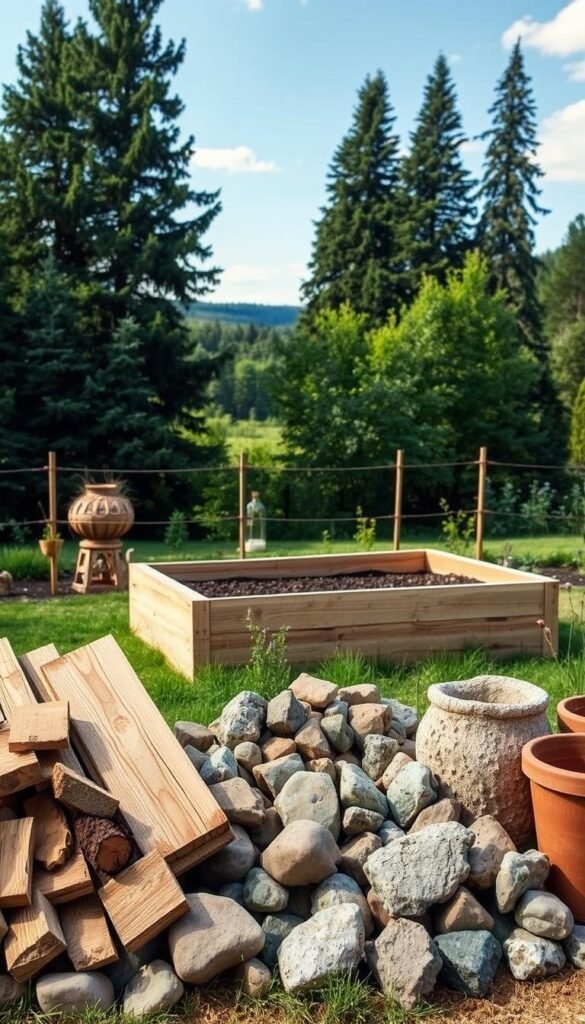
The right materials not only look great but also ensure your outdoor space thrives year after year. Your selection impacts durability, maintenance needs, and how well your planters blend with existing structures.
Wood and Cedar Elegance
Cedar stands out as a top choice for its natural resistance to decay and insects. This warm-toned wood develops a silvery-gray finish over time, adding character to your landscape. It’s lighter than many hardwoods, making DIY projects more manageable.
Brick, Stone, and Galvanized Options
For permanent installations, brick offers timeless charm that pairs well with traditional homes. Stone materials like slate or limestone create sophisticated borders, though they often need professional installation. Modern metal beds with powder-coated finishes resist rust while offering sleek lines.
| Material | Durability | Maintenance | Style |
|---|---|---|---|
| Cedar | 10-15 years | Low | Rustic |
| Brick | 25+ years | None | Classic |
| Stone | Lifetime | None | Luxury |
| Galvanized Steel | 20+ years | Wipe clean | Modern |
Mix materials creatively – pair stone corners with wooden sides, or add metal accents to brick planters. This approach lets you match your home’s exterior while creating unique visual interest. Remember: your chosen components should work as hard as your plants do!
Maximizing Functionality with Superior Drainage and Soil Control
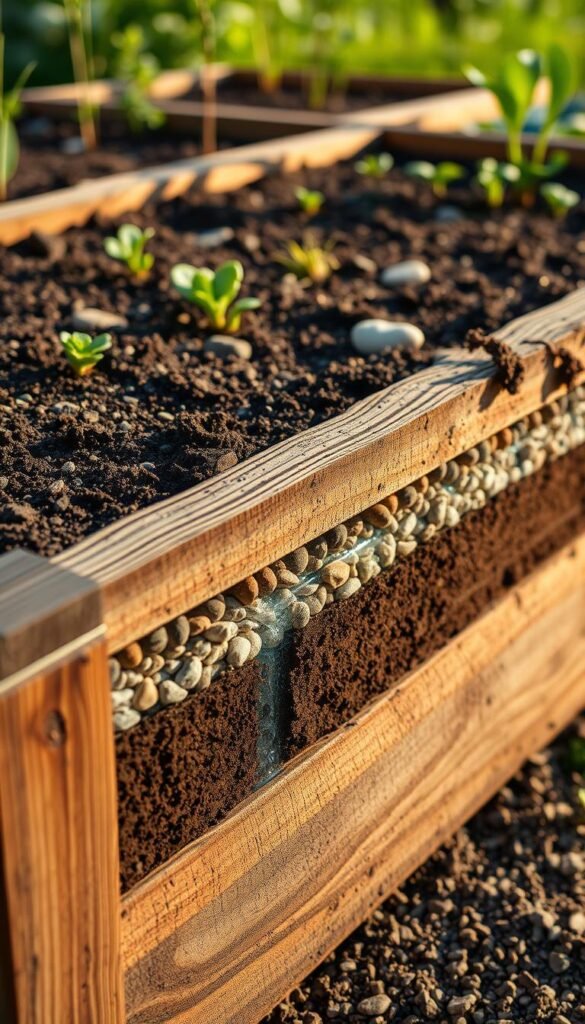
What if you could solve two common growing challenges with one smart solution? Elevated planters give you complete command over moisture levels and earth composition. This means healthier roots and tastier harvests, even in tricky landscapes.
Custom soil blends become your secret weapon. Mix compost, peat moss, and perlite to create a fluffy texture that drains quickly yet holds nutrients. Your tomatoes will thrive in this tailored environment while carrots enjoy loose, stone-free layers.
Traditional gardens often struggle with water management. Elevated structures let excess moisture escape through their open bases. No more soggy roots during rainy springs! Pair this with targeted strategies to improve soil drainage for unbeatable results.
- Layer materials like gravel at the base for extra protection
- Adjust pH levels using lime or sulfur as needed
- Install drip irrigation for precise watering
Watch how your greens respond to consistent moisture levels. The contained earth stays put during storms, preserving your perfect mix. You’ll spend less time fixing problems and more time enjoying vibrant growth.
Innovative Layouts for Maximizing Your Outdoor Space
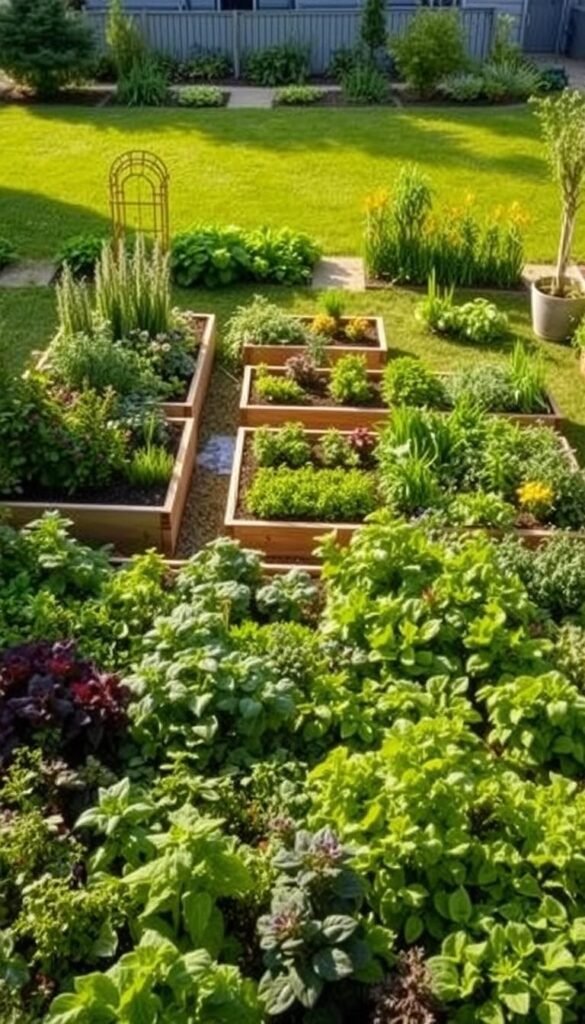
Unlock your yard’s hidden potential with spatial arrangements that turn limitations into opportunities. Clever configurations help you grow more while creating inviting areas that feel both practical and playful.
Rectangular and Circular Designs
Classic rectangles remain popular for good reason. Their straight edges make planting rows effortless and pair well with standard tools. You’ll maximize growing zones while keeping pathways clearly defined.
Round shapes break the mold beautifully. Curved edges create natural gathering spots for plants, and their 360° access simplifies watering. Try circling a fruit tree with herbs—it’s pretty and pest-resistant!
Triangular and Bucket Raised Beds
Angled configurations shine in tight spots. Fit three-sided planters into corners or along fences where rectangles won’t work. You’ll gain planting real estate without crowding walkways.
Portable bucket systems let you experiment freely. Cluster them for dense crops like strawberries, then spread them out as plants mature. Mix with permanent structures for evolving displays that match your mood.
- Pair tall triangular units with low circular planters for depth
- Use rectangular beds along property lines for clean borders
- Alternate shapes along pathways to guide the eye
Incorporating Trellises for Vertical Growth
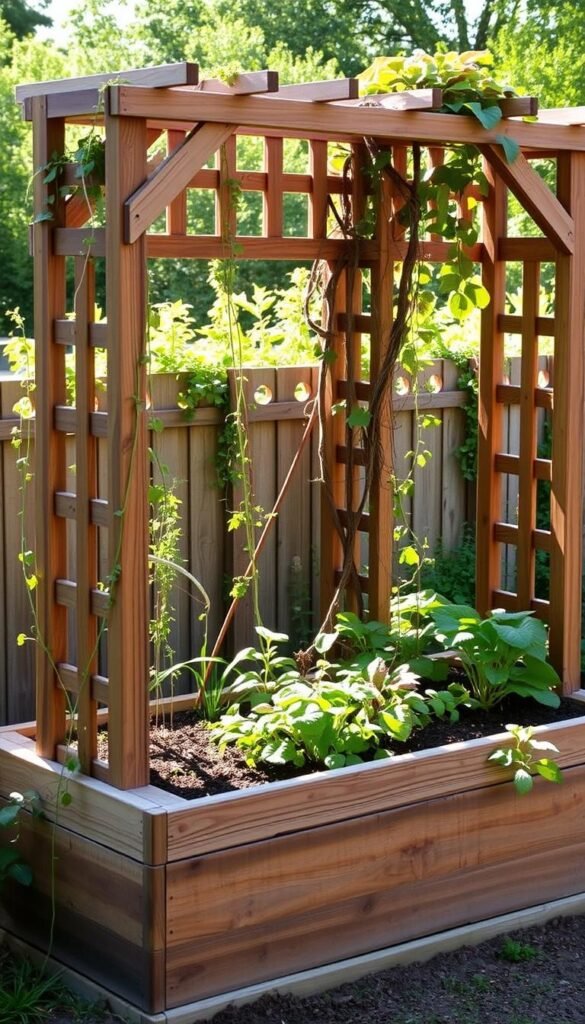
What if your green space could reach new heights? Vertical structures transform how you use every square foot, turning walls of leaves into living art. Trellises add dimension while solving practical challenges in tight areas.
Selecting the Right Trellis Style
Match your support system to your plants’ personalities. Delicate pea vines flourish on lightweight bamboo grids, while heavyweight squash needs sturdy metal frames. For a touch of whimsy, try curved arches that double as entryways to your growing zone.
Modern wire panels create sleek backdrops for flowering vines, while reclaimed wood lattices add rustic charm. Teepee designs offer instant visual interest—perfect for kids’ gardens or how to build a raised bed projects needing quick setup.
Benefits for Climbing Plants
Vertical growth isn’t just pretty—it’s practical. Air circulates freely around leaves, slashing mildew risks. Fruits stay clean and visible, making harvests faster. One gardener noted, “My cucumber yield tripled once I stopped letting them sprawl on the ground.”
Vining vegetables like pole beans stretch toward sunlight without competing for root space. Flowering climbers create natural privacy screens, their blooms shifting with the seasons. You’ll maximize production while keeping pathways clear and accessible.
Creative Pathways: Defining and Carving Garden Areas
Transform your outdoor space with pathways that do more than guide your steps. Strategic walkways carve distinct zones while adding structure to your layout. They turn chaotic patches into intentional areas where every plant gets its spotlight.
Brick and stone pavers outshine gravel by offering year-round comfort underfoot. These materials stay slip-resistant after rain and won’t scatter into planting zones. Choose colors that mirror your home’s exterior for a polished look that ties everything together.
Wider paths (36-48 inches) accommodate wheelbarrows and group strolls, while narrow ones (18-24 inches) create intimate nooks. Curved routes add mystery, inviting exploration of hidden corners. Straight lines project formality, perfect for modern spaces.
| Material | Durability | Maintenance | Best For |
|---|---|---|---|
| Brick | 25+ years | Occasional weed removal | Traditional designs |
| Stone | Lifetime | None | Natural landscapes |
| Gravel | 5-7 years | Rake level | Casual areas |
| Mulch | 2-3 years | Annual refresh | Budget-friendly |
Incorporate solar lights along edges to safely navigate your backyard after sunset. This subtle glow highlights plants while creating ambiance. For cohesive garden aesthetics, match pathway textures to nearby structures like benches or planter borders.
Smart routing protects plants from trampling and soil compaction. You’ll harvest tomatoes without stepping on delicate herbs nearby. Clear walkways also make mowing easier—no more awkward angles around unruly beds!
Stylish Steps and Tiered Garden Designs
Transform your sloped backyard into a living masterpiece with multi-level arrangements. Tiered layouts turn challenging terrain into functional art, blending stone accents with cascading greenery. These structures create depth while solving practical issues like erosion and uneven sunlight distribution.
Sloped yards become assets when you build upward. Retaining walls crafted from local stone or weather-resistant wood hold soil in place while adding texture. Each level acts as its own microclimate—plant sun-loving veggies on south-facing tiers and shade-tolerant herbs higher up.
Integrated steps do double duty as design features. Wide stone slabs create natural transitions between planting zones, letting you navigate steep areas safely. For budget-friendly options, try building raised beds using repurposed materials like railway ties or concrete blocks.
- Upper tiers drain excess water to lower levels naturally
- Mix edible and ornamental plants for year-round visual impact
- Add built-in benches where tiers meet for resting spots
Morning light hits lower elevations first, warming cool-weather crops like spinach. As the sun climbs, upper shelves bask in midday rays—perfect for peppers and basil. This smart layout ensures every plant gets its ideal conditions without constant adjustments.
Even flat spaces benefit from artificial elevation changes. Stacked planters create vertical interest, drawing the eye upward. Pair angular stone planters with curved pathways to soften the look. You’ll craft an outdoor sanctuary that feels both organized and inviting.
Lighting & Ambiance: Extending Garden Enjoyment into the Evening
As daylight fades, your outdoor oasis doesn’t have to disappear into shadows. Strategic illumination transforms your green space into a glowing retreat where fireflies compete with twinkling LEDs. String lights draped overhead turn vegetable patches into enchanting dining areas—perfect for summer gatherings under the stars.
Solar-powered options eliminate messy wires while keeping energy costs low. Line pathways with subtle stake lights that guide feet and highlight leafy borders. For drama, position spotlights at bed corners to cast dramatic shadows through ornamental grasses.
Smart zoning lets you switch moods instantly. Bright task lighting near herbs makes evening harvesting easy. Dimmer settings over seating areas create cozy nooks for unwinding. One gardener shared, “Our backyard became the neighborhood’s favorite spot once we added adjustable brightness controls.”
| Light Type | Best Use | Energy Source |
|---|---|---|
| String Lights | Overhead Canopy | Solar/Plug-In |
| Pathway Markers | Edge Definition | Solar |
| Spotlights | Architectural Focus | Low-Voltage |
| Lanterns | Tabletop Ambiance | Battery |
These touches boost your home’s evening appeal while making the area safer. You’ll find new reasons to linger outdoors long after sunset—sipping coffee amid firefly flickers or hosting memorable dinners bathed in golden light.
Your structured growing space becomes more than dirt and plants—it’s where creativity meets earth. Through smart layouts and material choices, you’ve built an environment that works with nature, not against it. Every curve, height adjustment, and plant pairing reflects your unique vision.
Remember: great spaces evolve. Swap out seasonal blooms or experiment with new textures as your skills grow. Those clever drainage solutions and vertical supports will keep serving you year after year. What started as practical planters now tells your story through changing harvests and color palettes.
Let this be your invitation to play. Mix stone borders with unexpected metal accents. Train morning glories up repurposed ladders. With each tweak, you’re not just growing plants—you’re cultivating joy. Share your triumphs online, then watch how neighbors start reimagining their own yards!

